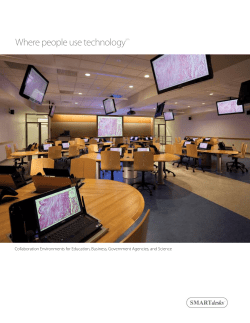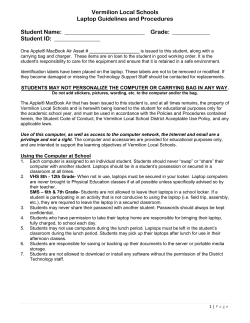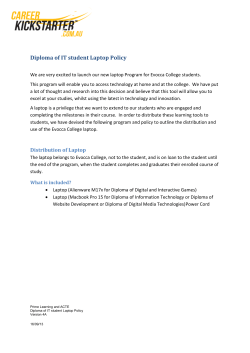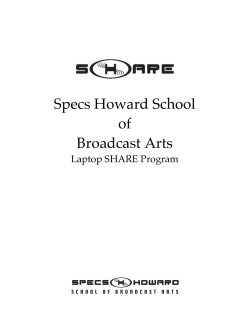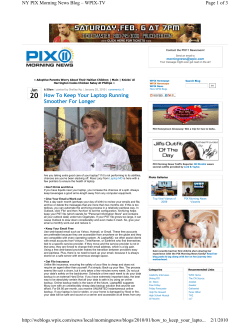
Laptop Survey Brought to you by: Dan Melville, Kait Matula,
Laptop Survey Brought to you by: Dan Melville, Kait Matula, Mike Pelletier, and Corey Pinney Introduction • There are many different types of laptops available on the market • Laptops are vital to students on campus for different reasons: school, major, projects, media. We have taken the initiative to find out which laptops currents students have on campus in correlation to the majors • We hope to provide information that could further be beneficial to students looking to purchase a laptop here on campus as well as incoming students. Problem Statement • Research is necessary to determine the most important aspects of a laptop computer for a Franklin Pierce University student. Research Objectives Identify the most important features Franklin Pierce University students want in a laptop. To determine what brands/models college students use and why. Identify the brand with the most effective and reliable customer service/tech support Identify features of laptops that students do not currently have but want. Literature Review • 75% of students college students have reported owning a laptop. (13) • According to US & World Report: • 40 Gigabyte hard drive (minimum) • 512 MB of Memory (minimum) (7) • Apple computers that run Macintosh now use Intel’s Core Duo chips • Just like HP and Dell models • Can now run Microsoft applications (9) • WiFi is a must • Worth the added cost (7) Literature Review Continued… • “Fashion, whether it’s in a cell phone or laptop, is at least as important as function when considering “essential” products.” (8) • McEwen, William J. PhD • Students prefer smaller laptops to carry. (2) • Apple sells the thinnest and lightest models (9) • Fallowed by Dell (12) • Screen Size • Larger screens are less strenuous on the users eyes(9) • Best battery life is between 6 – 8 hours (7) Literature Review Continued… • Media features • Television tunes (1), different types of speakers (9), gaming and multimedia capabilities. (9) • Price • Average price range = $700 – $1,300 (9),(7) • Can be as expensive as $3,000 and up (7) • Can be as low as $200 – $300 for used or mini laptop. Methodology Nature of the Problem There is a vast pool of components that go into computers, if uneducated on different matters, one might not find the computer that suits their needs Development of Survey Through research team identified information concerning laptop features, hardware etc. In class review of surveys Information from secondary sources Methodology Continued… Definition of Population Students at Franklin Pierce University 1,391 students are currently undergraduate Sample Size 160 students 80 male and 80 female 20 females and 20 males from each class standing totaling 40 students from each class Methodology Continued… Data Collection Method Team used a non-probability convenience sampling method Team handed out surveys at various locations consisting of the cafeteria, dorms, ….. Assumptions That everyone answered honestly and to the best of their ability That everyone answered all the questions Methodology Continued… Assumptions Students working with either Windows machines or Macintosh All students taking survey owned a laptop Respondents owned certain brands but also gave the opportunity to indicate otherwise Limitations Time Estimated stratified sampling Types of Survey Questions Asked 1) 2) 3) 4) 5) 6) 7) 8) 9) Which brand of Laptop do you own? Nominal How long have you had your laptop for? Nominal How often do you use your laptop outside of your dorm room? Nominal How long does your battery last for? Scale How often does this limit your computer activities? Nominal Rate the Following hardware features of a laptop on their importance. (1 being least important 5 being most important) (screen size, battery life, media capabilities, Portability, Wi-Fi, Fill Keyboard) Scale What is your preferred screen size? Nominal Wi-Fi capabilities are import to me, please rate on scale of 1(strongly disagree10(strongly agree) Scale How concerned were you with the warrantee that came with your laptop? Nominal Types of Survey Questions Asked… 10) How long is the warranty on your laptop for? Nominal 11) How many times per semester do you call tech support? Nominal 12) On a scale of 1-5 how indicate how satisfied you were with the way your problem was handled by tech support. Nominal 13) Who paid for your laptop? Nominal 14) What was the budget for purchasing the laptop? Nominal 15) Please indicate your gender. Nominal 16) What is your class standing? Nominal 17) What is your major here at Pierce? Open-ended Results Question 1 Results Question 2 Results Question 3 Results Question 4 Results Question 5 Results Question 6 Results Question 6 - Percents Results Question 7 Results Question 8 Results Question 9 Results Question 10 Results Question 11 Results Question 12 Results Question 13 Results Question 14 Results Question 15 Results Question 16 Results Question 17 Major/Brand Crosstab Budget/Brand Crosstab Screen Size Importance/Brand Crosstab Battery Importance/Brand Crosstab Media Capabilities Importance/Brand Crosstab Portability Importance/Brand Crosstab WIFI Importance/Brand Crosstab Full Keyboard/Brand Importance Tech-support/Brand Crosstab Discussion • Our research shows that 37.5% of respondents bring their laptop out of the dorm room almost everyday and just over a quarter claim to do so at least once a week. • 36.2% of participants indicated ownership of an Apple laptop and 21.9% indicated Dell. • Secondary sources say that Apple makes the most portable laptops, followed by Dell. • The most popular screen sizes among participants was 15 in. with 50%, followed by 17 in. with 18.8% • Researches documented 15 in. and 17 in. screens to be the most popular for laptops. Discussion Continued • Participants Strongly agreed that Wi-Fi was important by choosing 10 on a scale of 1 – 10. (44.4%) • 9 was the next most common response with 20.6%, the slope continued downward. • The students agreed with sources that accept Wi-Fi capabilities as a requirement for new laptops. • A third of respondents indicated that the budget for a their laptop was between $900 and $1200. 20.6% reported having a budget between $600 and $900. • This directly correlates sources that state that the average price new laptops retail at is between $700 and $1300. Conclusion • Capabilities • WIFI most important • Screen Size least important • Prominent Brands • Apple most prominent • ¾ of students use Apple, Dell, and HP • Satisfaction with Tech Support • Toshiba most satisfied • Apple and Dell satisfied • HP least dissatisfied • Necessities • Over 95% agree on WIFI Recommendations • Incoming Freshmen Orientation, further information could be provided about laptops and different specifications • IT department follow through with knowing various information about different laptops that are used on campus • Packets can be sent out to potential Franklin Pierce Students in regards to purchasing a laptop • Information in regards to processors, hard drive, optical, screen size, pricing, warranty wireless, software, etc. References 1. AND TODAY'S MUST-HAVE CAMPUS GEAR. (2007). Popular Science, 271(3), 54. Retrieved from Academic Search Premier database. 2. Carlson, S. (2006). For Commuting Students, Laptops Are Too Bulky. Chronicle of Higher Education, 53(5), A32. Retrieved from Academic Search Premier database. 3. CBS Interactive Inc. (2010). Consumer Reports “Getting Started” http://www.mysimon.com/consumer-reports/computers-buying-tips 4. Chong Leng, T., & Morris, J. (2005). UNDERGRADUATE COLLEGE STUDENTS, LAPTOP COMPUTERS, AND LIFELONG LEARNING. JGE: The Journal of General Education, 54(4), 316-338. Retrieved from Academic Search Premier database. 5. Feldmann, L., Wess, L., & Moothart, T. (2008). An Assessment of Student Satisfaction with a Circulating Laptop Service. Information Technology & Libraries, 27(2), 20-25. Retrieved from Academic Search Premier database. 6. Jefferson, G. (n.d). (2010) Musicians ditch studios for computers. USA Today, Retrieved from Academic Search Premier database. 7. M. K. F., A. (2004). Learning to lug the right laptop. U.S. News & World Report, 136(13), 65. Retrieved from Academic Search Premier database. 8. McEwen, William J. PhD. “High-Tech Products: The New Necessities.” Gallup. (2005)http://www.gallup.com/poll/20530/HighTechProducts-New-Necessities.aspx 9. Park, A. (2006). Big Laptops On Campus. Business Week, (3997), 68-69. Retrieved from Academic Search Premier database. 10. Read, B. (2006). ONLINE. Chronicle of Higher Education, 53(16), A28. Retrieved from Academic Search Premier database. 11. Strohmeyer, R. (2010). Lost!. PC World, 28(5), 85-91. Retrieved from Academic Search Premier database. 12. Top Ten Tech Tools. (2006). Careers & Colleges, 27(1), 18-20. Retrieved from Academic Search Premier database. 13. “Totally Wired Campus – The Class of 2013 Gets High “Tech” Grades.” Harris Interactive. (2009).<http://www.harrisinteractive.com/vault/Client_News_Alloy_Media_Marketing_2009_11.pdf> Questions? Thank you!
© Copyright 2025

